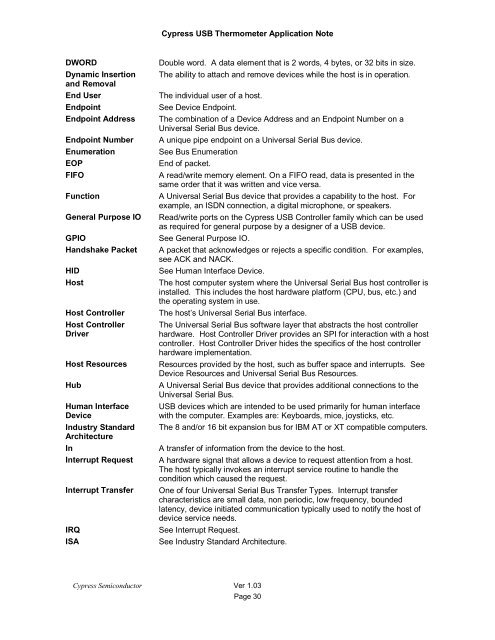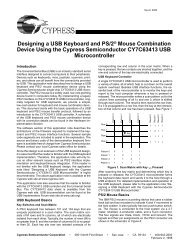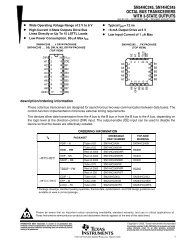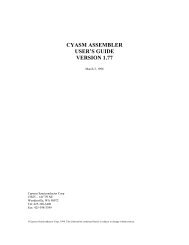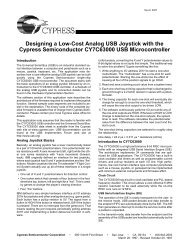Designing a Universal Serial Bus (USB) Device Using the Cypress ...
Designing a Universal Serial Bus (USB) Device Using the Cypress ...
Designing a Universal Serial Bus (USB) Device Using the Cypress ...
You also want an ePaper? Increase the reach of your titles
YUMPU automatically turns print PDFs into web optimized ePapers that Google loves.
<strong>Cypress</strong> <strong>USB</strong> Thermometer Application Note<br />
DWORD<br />
Dynamic Insertion<br />
and Removal<br />
End User<br />
Endpoint<br />
Endpoint Address<br />
Endpoint Number<br />
Enumeration<br />
EOP<br />
FIFO<br />
Function<br />
General Purpose IO<br />
GPIO<br />
Handshake Packet<br />
HID<br />
Host<br />
Host Controller<br />
Host Controller<br />
Driver<br />
Host Resources<br />
Hub<br />
Human Interface<br />
<strong>Device</strong><br />
Industry Standard<br />
Architecture<br />
In<br />
Interrupt Request<br />
Interrupt Transfer<br />
IRQ<br />
ISA<br />
Double word. A data element that is 2 words, 4 bytes, or 32 bits in size.<br />
The ability to attach and remove devices while <strong>the</strong> host is in operation.<br />
The individual user of a host.<br />
See <strong>Device</strong> Endpoint.<br />
The combination of a <strong>Device</strong> Address and an Endpoint Number on a<br />
<strong>Universal</strong> <strong>Serial</strong> <strong>Bus</strong> device.<br />
A unique pipe endpoint on a <strong>Universal</strong> <strong>Serial</strong> <strong>Bus</strong> device.<br />
See <strong>Bus</strong> Enumeration<br />
End of packet.<br />
A read/write memory element. On a FIFO read, data is presented in <strong>the</strong><br />
same order that it was written and vice versa.<br />
A <strong>Universal</strong> <strong>Serial</strong> <strong>Bus</strong> device that provides a capability to <strong>the</strong> host. For<br />
example, an ISDN connection, a digital microphone, or speakers.<br />
Read/write ports on <strong>the</strong> <strong>Cypress</strong> <strong>USB</strong> Controller family which can be used<br />
as required for general purpose by a designer of a <strong>USB</strong> device.<br />
See General Purpose IO.<br />
A packet that acknowledges or rejects a specific condition. For examples,<br />
see ACK and NACK.<br />
See Human Interface <strong>Device</strong>.<br />
The host computer system where <strong>the</strong> <strong>Universal</strong> <strong>Serial</strong> <strong>Bus</strong> host controller is<br />
installed. This includes <strong>the</strong> host hardware platform (CPU, bus, etc.) and<br />
<strong>the</strong> operating system in use.<br />
The host’s <strong>Universal</strong> <strong>Serial</strong> <strong>Bus</strong> interface.<br />
The <strong>Universal</strong> <strong>Serial</strong> <strong>Bus</strong> software layer that abstracts <strong>the</strong> host controller<br />
hardware. Host Controller Driver provides an SPI for interaction with a host<br />
controller. Host Controller Driver hides <strong>the</strong> specifics of <strong>the</strong> host controller<br />
hardware implementation.<br />
Resources provided by <strong>the</strong> host, such as buffer space and interrupts. See<br />
<strong>Device</strong> Resources and <strong>Universal</strong> <strong>Serial</strong> <strong>Bus</strong> Resources.<br />
A <strong>Universal</strong> <strong>Serial</strong> <strong>Bus</strong> device that provides additional connections to <strong>the</strong><br />
<strong>Universal</strong> <strong>Serial</strong> <strong>Bus</strong>.<br />
<strong>USB</strong> devices which are intended to be used primarily for human interface<br />
with <strong>the</strong> computer. Examples are: Keyboards, mice, joysticks, etc.<br />
The 8 and/or 16 bit expansion bus for IBM AT or XT compatible computers.<br />
A transfer of information from <strong>the</strong> device to <strong>the</strong> host.<br />
A hardware signal that allows a device to request attention from a host.<br />
The host typically invokes an interrupt service routine to handle <strong>the</strong><br />
condition which caused <strong>the</strong> request.<br />
One of four <strong>Universal</strong> <strong>Serial</strong> <strong>Bus</strong> Transfer Types. Interrupt transfer<br />
characteristics are small data, non periodic, low frequency, bounded<br />
latency, device initiated communication typically used to notify <strong>the</strong> host of<br />
device service needs.<br />
See Interrupt Request.<br />
See Industry Standard Architecture.<br />
<strong>Cypress</strong> Semiconductor Ver 1.03<br />
Page 30


